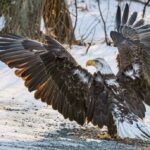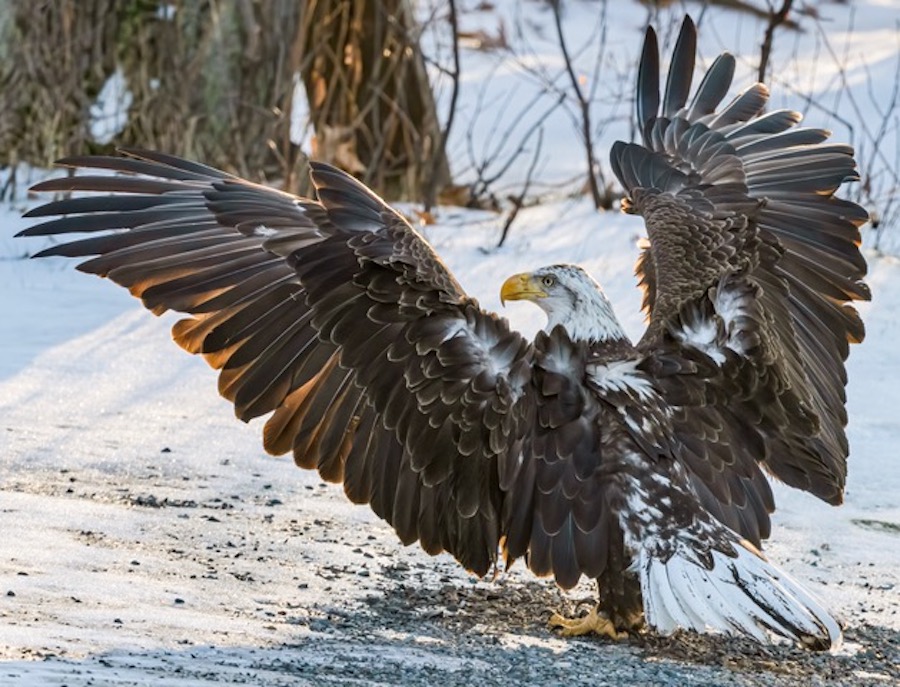
By David Morris
When I was young, I had an uncle who was attuned to nature. He was an artist, a hunter, a forager, and truly fascinating to an eight-year-old. Recently, after a frustrating morning trying to see some wildlife, I remembered his words. He’d said, “You need to remember that you are part of nature, too. You need to find a nice spot and just sit still. Don’t wait for when it’s time to move, but just enjoy the looking, the listening, and the sitting still. After a while, once you start to seem like one of them, the birds and the animals may start to show themselves.”
I’ve come back to that advice often in the 15 years since I started doing wildlife photography. I’ve learned to get outside and really pay attention. When I’m outdoors, I need to consider the light and the wind and my options with the camera, and if I’m lucky—and if I just sit still—I may enjoy a moment where I can observe nature going about its business.
I like to photograph birds. We see them all the time, but often we don’t really see them. I am especially fond of raptors and their details that emerge from photos: the play of feathers in the light and the wind as the hawks, owls, eagles, falcons, and other birds stake out their place in the food chain.
In late February, a female bald eagle known as MK was found struggling to fly in an Arlington cemetery. She was captured and taken to a wildlife care facility on Cape Cod, where she died from exposure to second-generation anticoagulant rodenticides (“SGARs”). She had likely eaten a rat that had eaten rat poison. (See “Law Could Prevent Eagle Poisoning,” BCF Newsletter, November/December 2021.)
MK’s story is both a remarkable success and a sad reminder that work is still needed to ensure that the nature around us has a fair chance to thrive. When I was growing up in the 1970s on the South Shore, there were no eagles flying around. Even red-tailed hawks were an unusual sighting!
With more focus on protecting habitat and restricting harmful chemicals, we have seen the raptors come back to take their rightful place in the natural chain. Now in my neighborhood on School Street in Belmont, it’s not unusual to see red-tailed hawks building nests, to hear a screech owl or great horned owl calling after dark, or to view the occasional peregrine falcon or bald eagle passing by. These incredible raptors are now established neighbors.
I first photographed MK in the fall of 2018, along with some other photographers, at the Mystic Lakes dam in Medford. We viewed this young (2½-year-old) bald eagle who seemed to be staying in the area rather than passing through as other eagles did on their way to watersheds further north. She was hanging around, and she was very sociable.
Her tag showed that she had been born along the Charles River in Waltham in the spring of 2016. She was a local—a bald eagle setting up shop in a busy suburban area just six miles from downtown Boston. It was incredible to see!
In the next few years, she was photographed by hundreds of people, viewed through binoculars, and noticed by people just walking by. Whether flying by the Mystic dam or sitting on the cross at the Church of St. Agnes in Arlington Center, she showed up in all kinds of places, giving many people their first-ever glimpse of a bald eagle.
While walking my dogs one morning, I saw her in a tree overlooking Clay Pit Pond by Belmont High School. She was maybe 25 feet up, watching the kids walk to school. MK would regularly sit on the football field’s light poles and occasionally fish in the small pond behind Fresh Pond Animal Hospital on Brighton Road. MK was a living, breathing, flying symbol of what good policy around nature can achieve.
Bald eagles start life in mottled brown and tan hues, looking more like strangely huge hawks than eagles. At three years, the eagle’s white head, tail, and yellow beak emerge, but it’s not until age five when an eagle is fully mature in appearance and ready to begin raising chicks. MK found her mate at age four and had her first chicks that year. Bad luck and the same SGARs that led to her demise also took the life of at least one of her chicks.
The pandemic led to a considerable increase in folks buying hiking boots, cameras, or binoculars and heading outside to look around. While some of the enthusiasm for nature has undoubtedly led to some bad behavior, it has also created a powerful information chain about the health of local raptors. This chain of observers allows local wildlife vets to get notified when seemingly healthy raptors are suddenly sick.
Sometimes animals just get sick, but the SGAR-related poisoning of eagles, hawks, owls, and other predators now seems to be a weekly occurrence. The raptors eat the poisoned rats or bring them home to their young, and our progress is halted. Eagles’ estimated mortality may be as high as 75% in the first year; statistics say that only 1 in 10 survive to adulthood (5 years of age). The story for other raptors is likely similar. Things are hard enough for these beautiful birds to survive without us making it harder.
The loss of MK to these poisons reminds me again of the sentiment my uncle shared. These raptors aren’t in a different category of life from us, and threats to their health will ultimately threaten ours. We know rats can be a nasty problem, but we can’t let the solution to that problem undo the progress that has been made on behalf of our neighborhood raptors. We owe them a solution they can live with.
For more information about local efforts to ban SGARs in Belmont and Massachusetts, contact savebelmontwildlife@gmail.com – Ed.
David Morris is a Belmont resident and avid nature photographer



Sorry, the comment form is closed at this time.